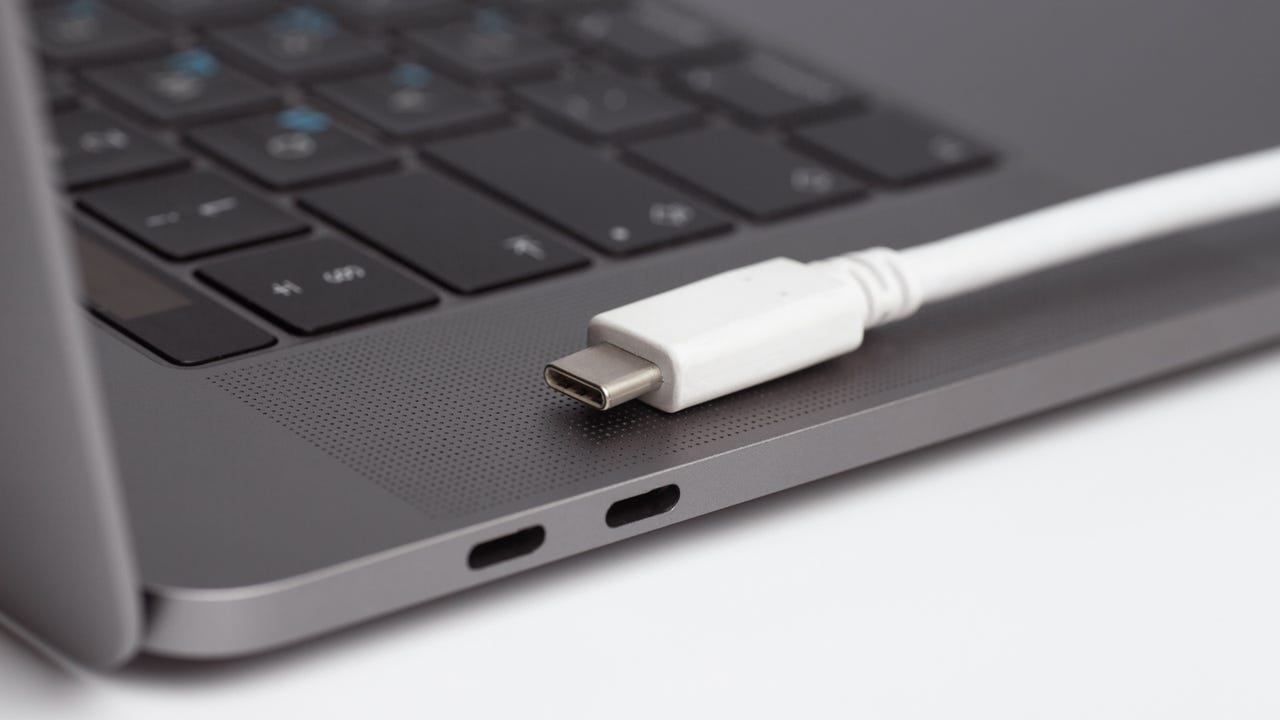
































Two Thunderbolt 3/USB4 ports nestled between a HagSafe portand3.5mm headphone jack on a MacBook Pro
At first glance, it might seem like we can happily say goodbye to all our old cables and switch to a single type of cable -- one that has USB-C connectors on both ends. After all, this handy cable fits into both USB-C and Thunderbolt ports, which are now commonly found on all modern desktops, laptops, smartphones, tablets, and various other devices.
Can we have one cable to rule them all? Oh, how I wish that were the case!
Also: This palm-sized Thunderbolt 4 dock handled my professional workflow like a beast
If one thing has caused people more confusion over the past few years, it is the fact that Thunderbolt and USB-C ports and cables look the same, but there are some key differences.
Let's clear up this confusion!
A lot of the confusion stems from the fact that USB-C, or more accurately, USB Type-C, refers to a 24-pin connector. This connector is utilized by various interface protocols, including USB, Thunderbolt, PCIe, HDMI, DisplayPort, among others.
Before this there were USB Type-A connectors, where the "A" indicated the host connector, and USB Type-B connectors, where the "B" signified the device or peripheral connector.
USB Type-C connectors have been designed such that they have the flexibility to serve as either host or device connectors.
While the design of this connector goes back to 2012, and the first smartphones to use it was released in 2015 (the Le 1 and Le Max), you didn't really start to see it much until 2017.
Also: I turned my laptop into a desktop PC and I've never been more productive
Note that you might come across cables for legacy devices that have a USB-C connector on one end and either a Type-A or Type-B connector on the other.
The USB-C connector is oval, and is symmetrical, so it can be inserted into the port either way, making it far more convenient than earlier USB connectors.
So it isn't Thunderbolt vs. USB-C, but Thunderbolt vs. USB. It's a small, but subtle distinction that adds to the confusion.
Thunderbolt is a protocol designed for connecting devices to computers, initially released in 2011. Nowadays, we're primarily focused on Thunderbolt 3 and Thunderbolt 4. Both of these advanced protocols utilize the USB-C connector.
The Thunderbolt 3 protocol, introduced by Intel, is a significant update to the Thunderbolt technology, offering advancements in speed, flexibility, and connectivity.
Thunderbolt 4 introduces several significant upgrades:
On the horizon is Thunderbolt 5, which dramatically improves on Thunderbolt 4:
The USB protocol is now almost 30 years old, and has seen numerous updates over the decades. Nowadays we're only concerned with USB 3.2 and USB4, both of which make use of USB-C connectors, although USB 3.2 can also use the older Type-A connectors.
Also: This 16-port dream dock belongs on every creative pro's desk
Since its release in 2019, USB4 has been the protocol of choice because it brings several improvements to the table, partly because it is itself based on the Thunderbolt 3 protocol.
Does this feel familiar? It should, because in terms of functionality, USB4 and Thunderbolt 3 or 4 are quite similar, and for a good reason. In terms of functionality, USB4 and Thunderbolt technologies share a lot in common, with both offering high data transfer rates, the ability to carry multiple types of data and video signals over a single cable, and support for high-power charging.
Also: The best portable power stations of 2024
The real difference lies in the certification process because Thunderbolt hardware requires mandatory certification from Intel to ensure a device makes the grade and can carry the official Thunderbolt branding.
All devices carrying the Thunderbolt logo have been subjected to rigorous testing to ensure compatibility, performance, and reliability.
Thunderbolt branding on an Anker Thunderbolt 4 cable
In contrast, USB4, while incorporating much of the Thunderbolt 3 capabilities, does not require the same level of certification to use the standard. This means that while USB4 devices can offer similar performance and features as Thunderbolt devices, the lack of certification means that users are not guaranteed the same level of compatibility, performance, and reliability.
This certification process means that Thunderbolt hardware has a bigger price tag compared to similar USB4 products.
There are Thunderbolt 3 cables, Thunderbolt 4 cables, USB 3.2 cables, USB4 cables, and then an ocean of cheap scabby cables that are everywhere.
If you have Thunderbolt hardware, you need Thunderbolt cables. I recommend getting Thunderbolt 4 cables, since they will be backward compatible with Thunderbolt 3 hardware, as well as anything that uses USB-C ports.
Also: The best USB-C cables for the iPhone 15: What the experts recommend
Yes, they're a bit pricier, but think of it as investing in peace of mind knowing you've got the right tool for the job.
If you don't care as much about compatibility, performance, and reliability, then buying a decent-quality USB-C cable should suffice.
Looking for a decent Thunderbolt cable? I like Anker's Thunderbolt 4 cable, available in2.3-foot and 6-foot offerings.
Thunderbolt, by and large, is for professionals who demand the very best from their hardware and are willing to pay whatever it takes for the best possible compatibility, performance, and reliability. These are the people who will be running multiple displays, editing loads of video and photos, and moving massive files to and from external drives.
Everyone else will be fine with USB 3.2 or USB4 hardware, which will be cheaper and more ubiquitous.
 Горячие метки:
Технологии и оборудование
Горячие метки:
Технологии и оборудование